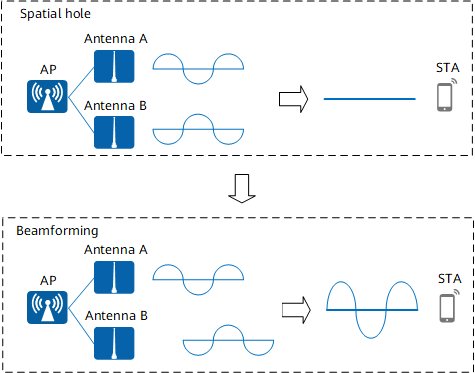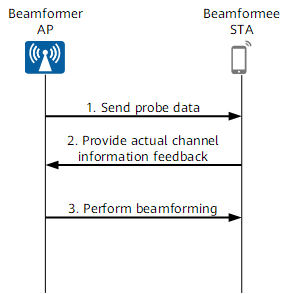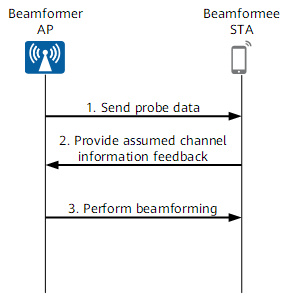What Is Beamforming?
Beamforming technology focuses radio signals towards wireless stations (STAs) in specific directions, thereby comprehensively improving the received signal strength indicators (RSSIs) of STAs and also increasing STA throughput. This technology is introduced to the Wi-Fi (also known as WiFi) field in Wi-Fi 4 (802.11n).
Why Is Beamforming Necessary for Wi-Fi?
Wi-Fi standards have been dedicated to increasing transmission rates. Since Wi-Fi 4 (802.11n) introduced multiple-input multiple-output (MIMO) and beamforming technologies, the maximum transmission rate has surged to hundreds of megabits per second and even higher.
MIMO technology multiplies transmission rates by adopting multi-antenna transmission. STAs in practice, however, usually have only one or two antennas each. This causes gain differences between the transmit and receive signals on the STAs. That is, when a STA sends signals to an AP, the AP can use its multi-antenna system to enhance the receive gain and achieve higher signal strength. It is not the case for reverse transmission. When an AP sends signals to a STA, if only antennas of the same number as those on the STA are used, the multi-antenna gain is not utilized. To address this issue, beamforming technology is introduced. It enables APs and STAs to negotiate higher transmission rates by increasing the RSSIs of STAs.
To ensure the AP's multi-antenna resources are fully utilized, Wi-Fi 5 (802.11ac) introduces multi-user MIMO (MU-MIMO) technology so that an AP can send signals to multiple STAs at the same time, improving wireless transmission efficiency. MU-MIMO is dependent on beamforming. Beamforming technology superimposes signals from multiple antennas of an AP so that each STA can receive only its own signals during MU-MIMO communication, preventing signal interference between the STAs. On top of that, the latest-generation Wi-Fi 6 (802.11ax) standard further increases the number of MU-MIMO users, which is also made possible by the use of beamforming.
How Does Beamforming Work?
How does beamforming form the shape of a beam? Signal beams are similar to light beams. The shape of a light beam produced by a flashlight is fixed. If another flashlight produces a light beam in the same direction, the two light beams are superimposed, thereby increasing the beam brightness and changing the beam shape. If more flashlights are used, the brightness and shape of the superposed beam both continue to change. In the case of multiple flashlights, turning on/off the flashlights or adjusting the light intensity also affects the beam shape.
Likewise, in wireless communication, an antenna emits radio beams like a flashlight. With multiple antennas, the radio beam shape can be adjusted by controlling radio signals transmitted by each antenna.
In a multi-antenna system, when signals transmitted by different antennas arrive at a location, a spatial hole may occur if two beams have equal attenuation but opposite phases. Beamforming technology enables two beams to be superimposed with the best effect by pre-compensating the phases of transmit antennas.

Beamforming implementation
Beamforming obtains and calculates parameters to be adjusted by detecting channel state information (CSI). According to CSI obtaining modes, beamforming can be implemented in the explicit or implicit mode.
Explicit Beamforming
Explicit beamforming requires a STA to provide CSI feedback. The following describes the CSI sounding and feedback process in explicit beamforming.

Explicit beamforming
- The AP sends sounding data (training symbol) to the STA. In 802.11n, sounding data can be sent through null data packets (NDPs) or staggered preambles; in 802.11ac, only NDPs are used.
- NDPs are null frames without data and have no payload. The AP sends an NDP Announcement frame and an NDP to the STA. After receiving these frames, the STA performs CSI feedback.
- Staggered preambles are payload frames that carry a MAC frame and a sounding channel.
- The STA provides CSI feedback to the AP.
In 802.11n, the following modes for CSI feedback are supported:
- CSI mode: The STA directly sends the raw CSI to the AP, and the AP calculates the final beamforming weight.
- Non-compressed beamforming weight: After receiving the sounding information, the STA calculates a beamforming weight value and sends the calculation result to the AP. This mode increases the system overhead. This is where the compressed beamforming weight comes in.
- Compressed beamforming weight: The STA calculates a beamforming weight value and sends the calculation result to the AP, while taking some measures to reduce the system overhead.
Since the 802.11ac standard, STAs have been required to provide CSI feedback in compressed beamforming weight mode.
- Based on weight information provided by the STA or calculated by the AP itself, the AP performs beamforming so that multipath signals are aggregated on the STA, forming gains.
Implicit Beamforming
The initial assumption of implicit beamforming is to free STAs from providing CSI feedback. Implicit beamforming leverages the reciprocity of a time division duplex (TDD) system. Reciprocity states that the uplink CSI and downlink CSI on a frequency band are identical. In this way, uplink CSI is directly applied to the downlink channel for beamforming.
Implicit beamforming is no longer supported from the 802.11ac standard due to its complexity.
As defined in 802.11n, the implicit beamforming process consists of CSI sounding and feedback, as shown in the following figure.

Implicit beamforming
In explicit beamforming, STAs provide actual CSI feedback; in implicit beamforming, the uplink CSI and downlink CSI are considered identical but the downlink CSI is not the actual CSI.
In practice, applying the uplink CSI to the downlink channel may be unable to achieve the desired effect due to the difference between the uplink and downlink channels. To ensure the beamforming effect, STAs still need to obtain the downlink CSI and offer it to the AP, assisting the AP in channel calibration. The calibration process is as follows:
- An AP sends a Calibration Start frame, which is also a Sounding Start frame, to a STA.
- After receiving the Calibration Start frame, the STA sends a response frame (Calibration Response frame + Sounding Response frame) to the AP, assisting it in estimating the uplink channel.
- Based on the response frame, the AP estimates the uplink channel and sends a calibration frame (Sounding frame + CSI Feedback frame) to the STA. This enables the STA to collect downlink CSI and requests the STA to provide CSI feedback to the AP.
- Author: Wang Yibo
- Updated on: 2022-04-02
- Views: 24718
- Average rating:







